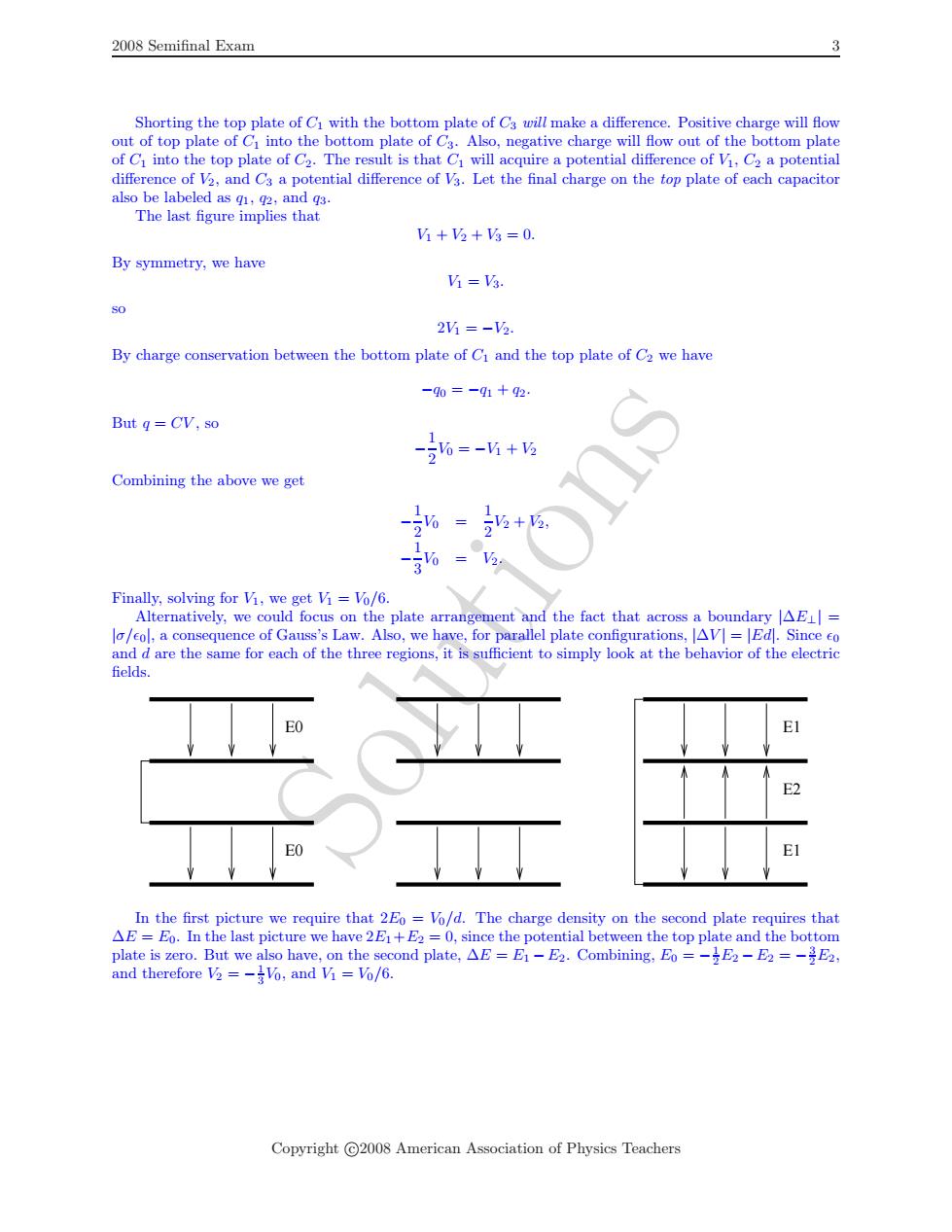正在加载图片...

2008 Semifinal Exam 3 Shorting the top plate of Ci with the bottom plate of C3 will make a difference.Positive charge will flow out of top plate of C into the bottom plate of C3.Also,negative charge will flow out of the bottom plate of Ci into the top plate of C2.The result is that Ci will acquire a potential difference of Vi,C2 a potential difference of V2,and C3 a potential difference of V3.Let the final charge on the top plate of each capacitor also be labeled as q1,q2,and 93. The last figure implies that M+2+=0. By symmetry,we have =. So 2VM=-2. By charge conservation between the bottom plate of Ci and the top plate of C2 we have -q0=-91+2: But g=CV,so -6=-+6 Combining the above we get +2, Finally,solving for Vi,we get Vi=Vo/6. Alternatively,we could focus on the plate arrangement and the fact that across a boundary AEL= lo/col,a consequence of Gauss's Law.Also,we have,for parallel plate configurations,AV=Ed.Since co and d are the same for each of the three regions,it is sufficient to simply look at the behavior of the electric fields. EO E2 EO In the first picture we require that 2Eo =Vo/d.The charge density on the second plate requires that AE Eo.In the last picture we have 2E1+E2=0,since the potential between the top plate and the bottom plate is zero.But we also have,on the second plate,AE=E1-E2.Combining;Eo =-E2-E2 =-E2, and therefore V2 =-Vo,and Vi Vo/6. Copyright C2008 American Association of Physics TeachersSolutions 2008 Semifinal Exam 3 Shorting the top plate of C 1 with the bottom plate of C3 will make a difference. Positive charge will flow out of top plate of C 1 into the bottom plate of C3. Also, negative charge will flow out of the bottom plate of C 1 into the top plate of C2. The result is that C 1 will acquire a potential difference of V1 , C2 a potential difference of V2, and C3 a potential difference of V3. Let the final charge on the top plate of each capacitor also be labeled as q 1 , q 2, and q 3 . The last figure implies that V1 + V2 + V3 = 0 . By symmetry, we have V1 = V3 . so 2 V1 = − V2 . By charge conservation between the bottom plate of C 1 and the top plate of C2 we have − q 0 = − q 1 + q 2 . But q = CV , so − 12 V0 = − V1 + V2 Combining the above we get − 12 V0 = 12 V2 + V2 , − 13 V0 = V2 . Finally, solving for V1, we get V1 = V0 /6. Alternatively, we could focus on the plate arrangement and the fact that across a boundary |∆ E ⊥| = |σ/ǫ0|, a consequence of Gauss’s Law. Also, we have, for parallel plate configurations, |∆V | = |Ed|. Since ǫ0 and d are the same for each of the three regions, it is sufficient to simply look at the behavior of the electric fields. E0 E0 E2 E1 E1 In the first picture we require that 2 E 0 = V0/d. The charge density on the second plate requires that ∆ E = E 0. In the last picture we have 2 E 1 + E 2 = 0, since the potential between the top plate and the bottom plate is zero. But we also have, on the second plate, ∆ E = E 1 − E 2. Combining, E 0 = − 12 E 2 − E 2 = − 32 E 2 , and therefore V2 = − 13 V0, and V1 = V0 /6. Copyright c 2008 American Association of Physics Teachers